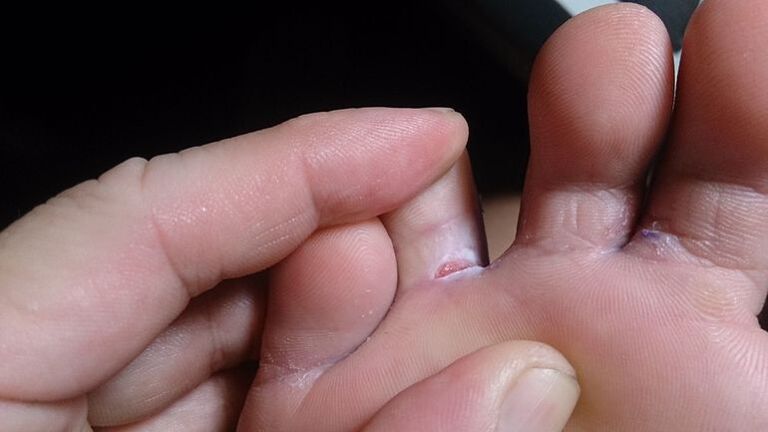
Mycoses is a group of diseases caused by pathogenic fungus.The skin area affecting this microorganism is called dermatomycosis.Sometimes they are combined with onychomycosis - nail disease.Knowing how fungus is seen in the feet, you can cure the disease on time and prevent complications.There are several options for this pathology.
The mechanism of an infection
There are factors that directly influence the ability to be infected with fungus.Also, many in this regard depend on the state of immunity.When the body's defense is reduced, the probability of micosis development increases significantly.Immunity can undermine chronic infectious diseases, endocrine system pathology.You can be infected with fungus in a straight and indirect way.In the first case, this happens through:
- soil layers;
- various plants;
- Contact an infected person or animal.
Indirect pathways involve the use of hygiene and other things that the patient is actively used.
The genus Candida mushrooms live on the surface of the epidermis.When the composition of the sweat glands changes, the nutrient medium for the development of microorganisms is formed.The Candida group representative obtained the pathogenic nature.This means they can cause disease easily.
The classification of mikosis

With epidermophytosis, the skin and nails are affected.You can be infected with the disease in public: in the gym, sauna.Through which pathogen objects are most often sent:
- towels;
- cloth;
- oil fabric;
- mat.
Men in adults experience epidermophytia more often.A favorable factor for the development of the disease is to increase sweating.
Trichophytosis can be caused by a variety of fungi from a group of Trichophyton.The disease is considered very contagious.It is transmitted through the shoes of the infected subject, the cloth, towel and other bath accessories.More pathology is found in children.About 17% is the prevalence of teenagers.Young men usually suffer.Among the adult men, the incident was bigger.Risk is workshop, bathing, bathing, athletes, miners.
Candidiasis stop, compared to epidermophytia, is less common.Most fungus of the genus Candida belongs to the pathogenic group.This means that these microorganisms are present in the human epidermis in the norm.They get pathogenic nature after the decline in immunity.
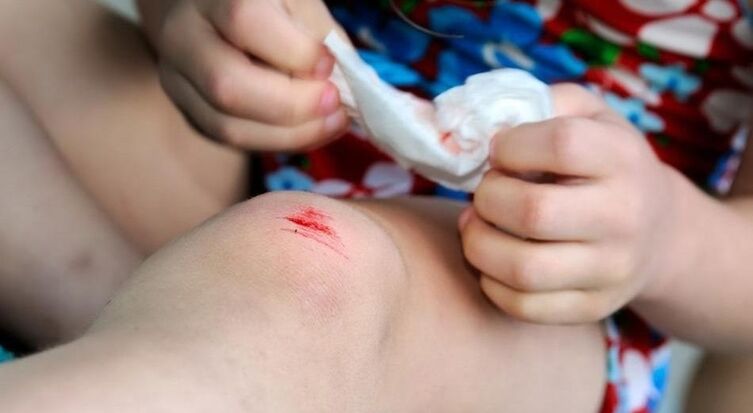
In order for Candida mushrooms to enter the body, it is sufficient to use the objects that the patient has.These microorganisms are often found in food products such as meat, milk and dairy.The risk of infection increases with the presence of these factors:
- Skin injury due to exposure to chemical, alkali and acid components;
- Maceration, sweating skin;
- The presence of fungus in the air in large quantities.
Symptoms of disease
By the nature of the course, rubramicosis and epidermophytosis are similar.For this reason, experts combine them into one category - stop moza.It is distinguished by scaly, dyshidrotic and intertriginosa shape.A separate group is onychomycosis, which can:
- atopic;
- normotrophic;
- Hypertrophic.
With dyshidrotic mycosis, the work of the sweat gland is prevented.The fungus on the finger with an intertrigonic form looks like a diaper rash.Although there is a division, it should often be considered conditional, as various variations of the disease are combined.
Squamous and dyshidrotic
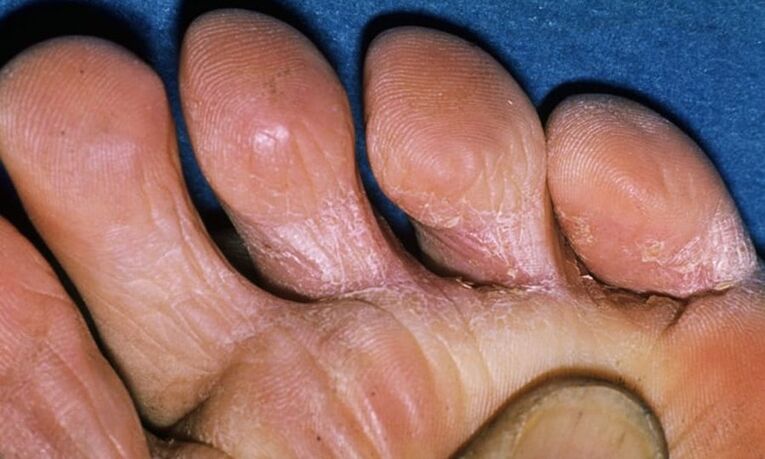
Initially, the squamous shape of the fungus affects one side.Then he turned to the opposite.The redness area is formed on the skin, which gradually begins to peel.Individual patients complain about itching.The damage area can be large and small, depending on the patient's body.Some people suffer from this form of mycosis, but no one is bothering them.
The fungus on the skin of the dyshidrotic shape looks specific: Bubbles form with a diameter of 2 to 8 mm in large quantities above the foot arch.Little by little, they began to join into a bigger formation, and then break.In their place, ulcerative skin lesions are formed.Sometimes the process is switched to the inside and external surface.The bubble is open, and where they can see the diaper rash area with erosion.
Fungus on the feet also shows itself in itching and pain.Erosion is in the future dry and cured, and peeling is formed in their place.Fungal infections can be complicated by bacteria.In this case, the liquid located in the bubble becomes cloudy.The skin on the feet is swollen, red.Dyshidrotic forms are characterized by long flow.Alternative remission period with exacerbations.Usually, fungus with this form only affects one foot.
An intrigin form
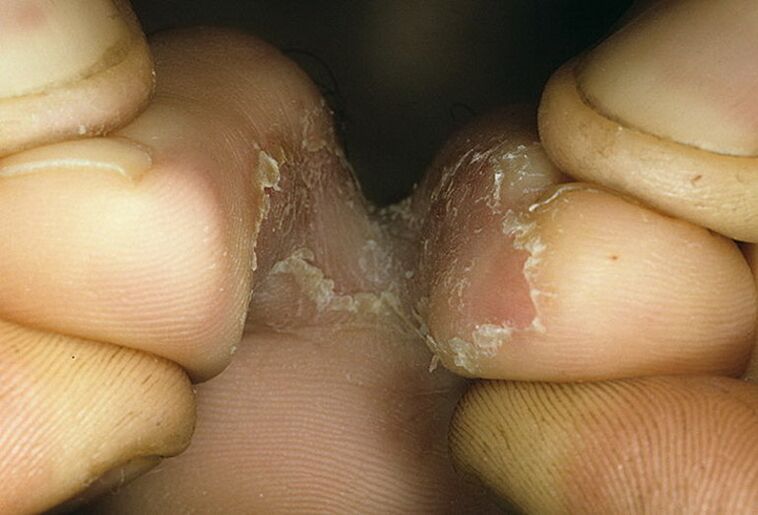
It has become the most widespread and has emerged independently.Less commonly, this form develops with the background of squamous mycosis.This process affects the area between the 4th and 5 -foot fingers.The main symptom is the appearance of cracks in the epidermis with white rims.The surface layer of the skin is removed.Between fingers, weakness is formed.The patient complains of burning and itching.In the field of lesions, it is quite painful to touch the form of erosion.
Intriginal forms are chronic in most cases, having long flow.This condition improves in winter and worsens in the summer.In patients with this form, the skin is loosened over time.His protective function is reduced.This creates an encouraging foundation for streptococcal infections.In the epidermis, abscesses are formed, surrounded by swelling and redness.
The type of onychomycosis
The disease causes damage to the nails on the fingers.The pathogen initially attacked the plate -free edge.Here, yellow shade and stains are formed.Some forms of onychomycosis are distinguished:
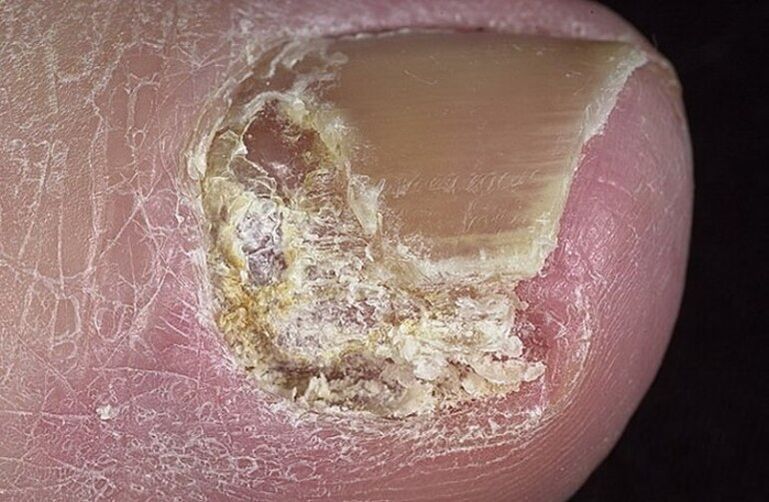
- Hypertrophic.The nails turn yellow, the thickness increases.She collapsed, and the skin underneath the skin and thickened.
- Atopic.The opposite condition is observed here, when the nails become thin and destroyed.The skin underneath is covered with a keratinized layer.
- Caused by mold.It is formed against the background of nail disease.The plates can be green, yellow, brown, and sometimes even black.Paronichia is formed in the periologe space - purulent inflammation.
In 70% of cases, onychomycosis affects 3, 4 and 5 fingers in the feet.In 30% of cases, 1 and 4 fingers suffer.Often, forms of normotropic disease are found when yellow spots are present on the nails, but their integrity is not violated.
Fungal treatment
There are various treatment schemes for the disease individually selected by the doctor.
Additional treatment methods include intake of immunostimulants and vitamins.They help strengthen immunity.If bacterial infections have combined, antibiotics are prescribed.Sometimes the occurrence of fungal infections is liked by underlying diseases.It must be treated in the first place.We talk about dermatological pathology and chronic infections.Antihistamines are recommended with the presence of allergic components.
Traditional medicine
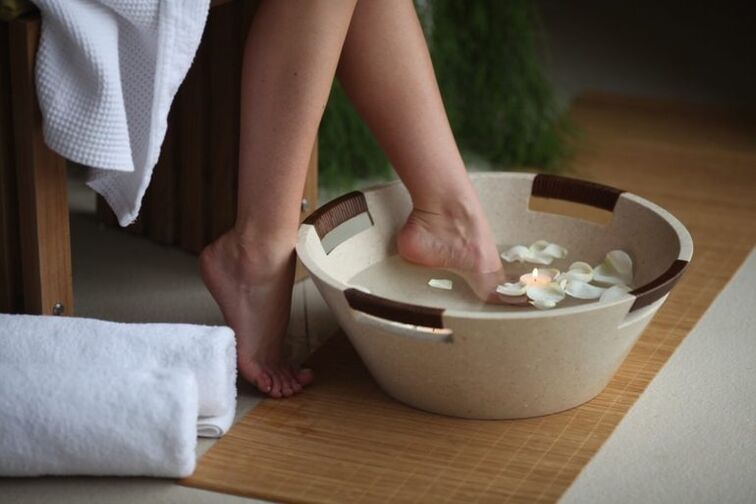
Mycoses do not pose a significant danger to health.But their presence helps reduce immunity, acting as a focus of inflammation.Only antifungal therapies that use specialized medicines help eliminate such problems.In the early stages, the use of folk recipes is allowed, which comes with basic therapy.What methods can be practiced:
- The reception of the bath;
- processing of affected areas with medicinal herbal decoctions;
- Application of ointment.
For bathing, you can take wine vinegar, as it has antiseptic effects.First you need to wash your feet with warm water and dry it.Then, wine vinegar is poured into water in a ratio of 1 to 2 and the feet are lowered into it.They hold them there for 5 minutes, after which they wear socks for the night and sleep.
Another version of the bath involves the use of soda and salt.Take one tablespoon of ingredients and dissolve in water.After that, lower the foot into the solution, holding no more than 15 minutes.At the end of the procedure, the feet are washed with warm water.
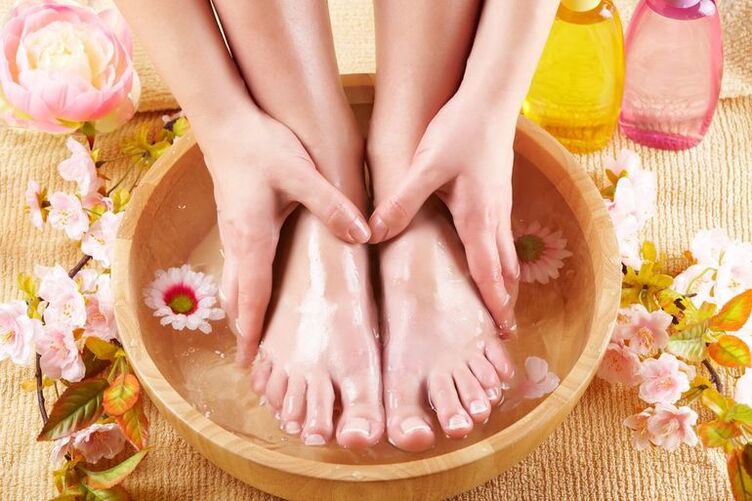
To treat feet with therapeutic decoctions, drug verbena and calendula inflorescence can be used.Also, oak bark, dry blackberry berries have a good antiseptic effect.The selected component is mixed with the same amount.3 tbsp.L. and pour a glass of water.Put on low heat for 15 minutes.Filter and moisturize the stew with the resulting boil.Also, this tool can be used for lotions.
To provide healing ointment, they mix with the same amount of pork fat and refined wood ash.The resulting ointment should be thick and has homogeneous consistency.It is used to clean and dry the feet twice daily: in the morning and evening.



























